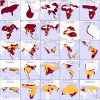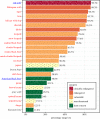Range contractions of the world's large carnivores
- PMID: 28791136
- PMCID: PMC5541531
- DOI: 10.1098/rsos.170052
Range contractions of the world's large carnivores
Abstract
The majority of the world's terrestrial large carnivores have undergone substantial range contractions and many of these species are currently threatened with extinction. However, there has been little effort to fully quantify the extent of large carnivore range contractions, which hinders our ability to understand the roles and relative drivers of such trends. Here we present and analyse a newly constructed and comprehensive set of large carnivore range contraction maps. We reveal the extent to which ranges have contracted since historical times and identify regions and biomes where range contractions have been particularly large. In summary, large carnivores that have experienced the greatest range contractions include the red wolf (Canis rufus) (greater than 99%), Ethiopian wolf (Canis simensis) (99%), tiger (Panthera tigris) (95%) and lion (Panthera leo) (94%). In general, the greatest range contractions occurred in Southeastern Asia and Africa. Motivated by the ecological importance of intact large carnivore guilds, we also examined the spatial extent of intact large carnivore guilds both for the entire world and regionally. We found that intact carnivore guilds occupy just 34% of the world's land area. This compares to 96% in historic times. Spatial modelling of range contractions showed that contractions were significantly more likely in regions with high rural human population density, cattle density or cropland. Our results offer new insights into how best to prevent further range contractions for the world's largest carnivores, which will assist efforts to conserve these species and their important ecological effects.
Keywords: carnivore guild; geographical range; historic; intact guild; livestock; predator.
Conflict of interest statement
We have no competing interests.
Figures





References
-
- Ripple WJ, et al. 2014. Status and ecological effects of the world's largest carnivores. Science 343, 1241484 (doi:10.1126/science.1241484) - DOI - PubMed
-
- Wolf C, Ripple WJ. 2016. Prey depletion as a threat to the world's large carnivores. R. Soc. open sci. 3, 160252 (doi:10.1098/rsos.160252) - DOI - PMC - PubMed
-
- Cardillo M, Purvis A, Sechrest W, Gittleman JL, Bielby J, Mace GM. 2004. Human population density and extinction risk in the world's carnivores. PLoS Biol. 2, e197 (doi:10.1371/journal.pbio.0020197) - DOI - PMC - PubMed
-
- Ceballos G, Ehrlich PR. 2002. Mammal population losses and the extinction crisis. Science 296, 904–907. (doi:10.1126/science.1069349) - DOI - PubMed
-
- Lomolino MV, Channell R. 1995. Splendid isolation: patterns of geographic range collapse in endangered mammals. J. Mammal. 76, 335–347. (doi:10.2307/1382345) - DOI
Associated data
LinkOut - more resources
Full Text Sources
Other Literature Sources

